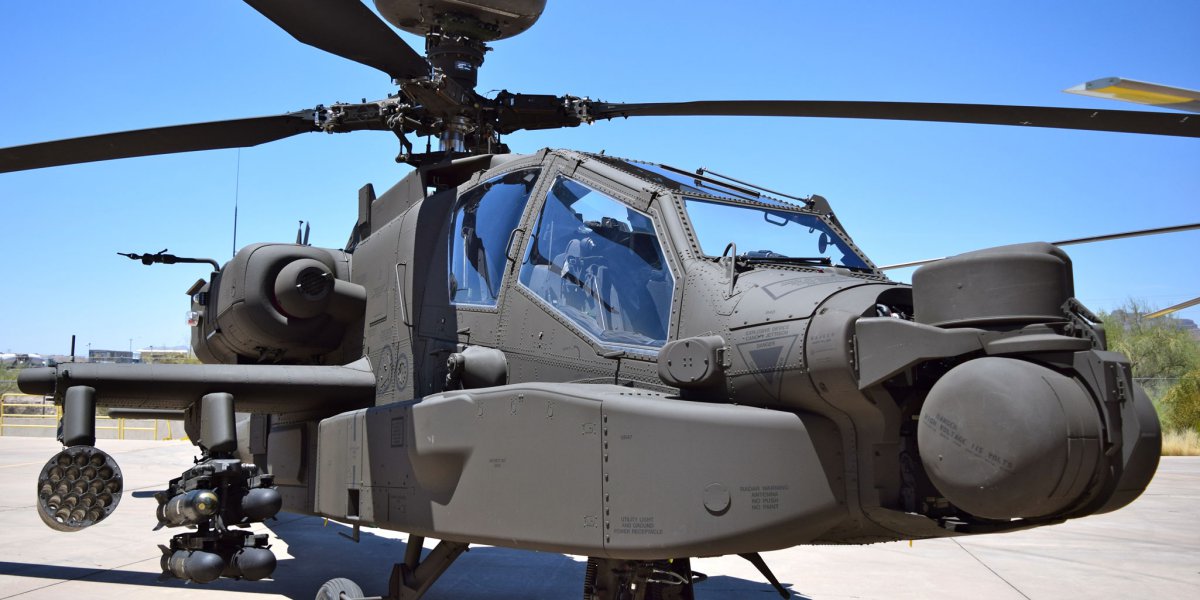The U.S. Army is developing a Version 6 update of the Boeing AH-64E Apache that by 2018 will enhance its fire-control radar, expand its ability to communicate with unmanned aircraft and soldiers on the ground, and increase onboard processing speeds. The work was underway as the service sought approval for its first multi-year procurement of the fearsome attack helicopter.
The “heavily software dependent” Version 6 capabilities will be implemented on the latest-model Apache by April 2018 at a cost of $298.5 million, according to a “Justification and Approval” document signed in April 2015 by Heidi Shyu, the Army’s senior procurement executive.
The technology insertions can be retrofitted at Apache unit locations, said Apache project manager Col. Jeffrey Hager, who briefed reporters on the project last month at the Boeing Defense manufacturing facility in Mesa, Arizona.
“We want to capture the best that technology has at that time; rather than build the airframe all at once, we’re going to make these incremental updates,” said Hager. “We did such a good job on putting the mission processors in the airplane that we can upgrade the software as we go along.”
Enhancements to the Apache’s AN/APG-78 Longbow fire-control radar will extend its range, improve its ability to recognize threats and enable over-water maritime targeting. “Current and potential future conflicts mandate the need for the Apache to counter enemy anti-access/area denial [threats] such as unmanned aircraft, amphibious assault vehicles and hovercraft, at extended ranges and under adverse weather conditions,” according to the project justification document.
Version 6 also calls for integrating soldier waveform radio voice and data capability “using the second channel” within the Apache’s Link 16 airborne terminal. This will “better support the warfighter while meeting the net-centric requirement to provide direct voice communications with supported soldiers and exchange individual position information to increase situational awareness and prevent fratricide within the joint fight.”
New multi-core mission processors will provide more memory and faster processing speeds. A cognitive decision aiding system will be integrated, helping to decrease pilot workload and improve decision making efficiency. Also integrated will be a modernized rocket launcher, and the capability to deploy the advanced AGM-114R “Hellfire Romeo” air-to-surface missile.
Manned-Unmanned Teaming
The update will also introduce the next-generation capability of -Extended, or “MUMT-X” enabling Apaches to interoperate with a wider range of unmanned aircraft systems (UAS) and other platforms.
Already, the crew of an AH-64E equipped with a tactical common data link (TCDL) can control the General Atomics MQ-1C Gray Eagle and the Textron Systems Shadow V2 in flight—so-called Level 4 capability. (Level 1 is the receipt and transmission of secondary imagery; Level 2 is receipt of imagery directly from the UAS; and Level 3 is control of the UAS payload.) MUMT-X calls for TCDL capability to be expanded to include C, L and S-band communications, Hager said.
Last September, L-3 Communications was awarded a subcontract from Science and Engineering Services for the MUMT-X upgrade, which it described as a wideband, high-speed video and data communications suite.
In addition to operating in multiple bands, the system was to include a Rover 6 modem for the remotely operated video enhanced receivers used by soldiers and forward air controllers, and an “innovative directional antenna capable of relaying multiple video streams back to the command center,” the company said at the time.
“When that comes out in the latter part of fiscal 2018, the [Apache] Echo model will be able to talk with any system that’s out there on the battlefield,” Hager said. “Right now, the requirement that was written for us was to talk to tactical common data link systems, which is the Gray Eagle and the Shadow V2. We can talk to those systems today; in a few short years, we’ll be the first airframe to talk to any systems out there on the battlefield, and that includes naval security assets, the Marines—anything that’s flying out in the airspace, they’ll be able to capture that data.”
During the press trip to the Mesa facility, the Army and Boeing (Chalet B6, OE G4) were negotiating a multi-year procurement for 275 AH-64Es—which are remanufactured from earlier versions—with options for up to 450 total helicopters, to include foreign military sales and additional U.S. Apaches.
According to Hager and Kim Smith, Boeing vice president of attack helicopter programs, the multi-year buy was approved by congressional oversight committees and the undersecretary of defense for acquisition, technology and logistics, Frank Kendall.
The contract would extend from Fiscal Years 2017 to 2021, providing “the capability to come back quickly to Boeing and ask for more airframes,” said Hager. “That’s really what it comes down to—we want speed and agility in how we do contracting operations. We’ve procured anywhere from 35 to 56 aircraft [annually]. It’s been very volatile over these last several years. That’s why we want to take on the stability of a multi-year contract.”
The parties expected to conclude the multi-year contract no later than the second quarter of FY2017, or between January and March next year. Boeing wanted to do it sooner. “We’ve been working very hard to see how we can pull that schedule to the left,” said Smith.
Source: AIN Online

